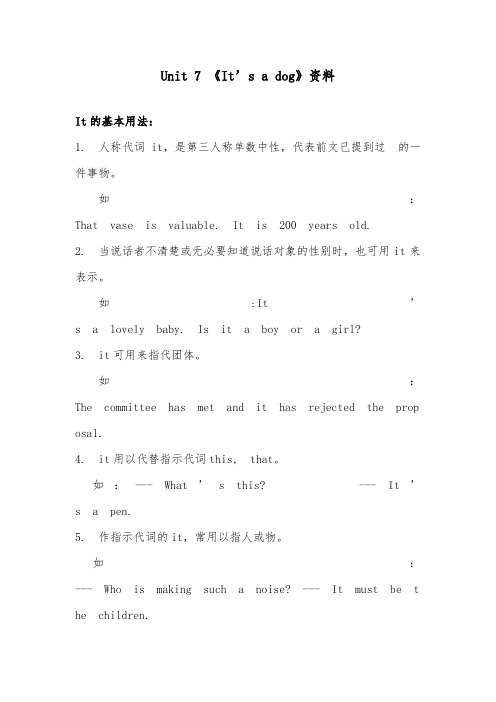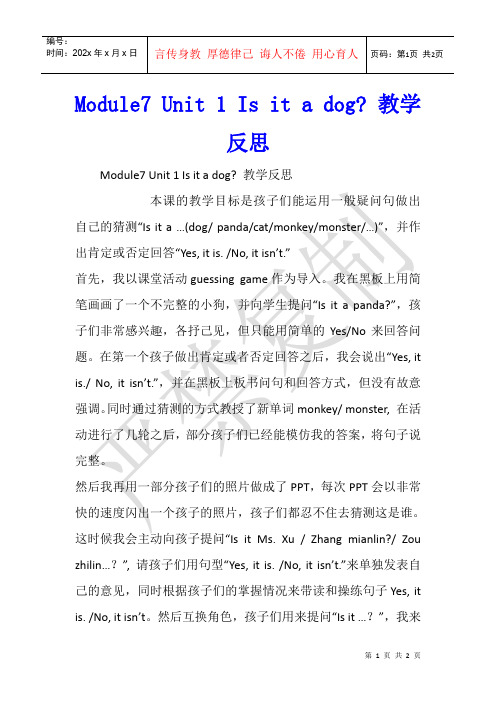Unit 7 It's a dog 教案
- 格式:doc
- 大小:36.54 KB
- 文档页数:3

Unit 7 《It’s a dog》资料It的基本用法:1. 人称代词it,是第三人称单数中性,代表前文已提到过的一件事物。
如:That vase is valuable. It is 200 years old.2. 当说话者不清楚或无必要知道说话对象的性别时,也可用it来表示。
如:It’s a lovely baby. Is it a boy or a girl?3. it可用来指代团体。
如:The committee has met and it has rejected the prop osal.4. it用以代替指示代词this, that。
如:--- What’s this? --- It’s a pen.5. 作指示代词的it,常用以指人或物。
如:--- Who is making such a noise? --- It must be t he children.6. it常作无具体意义的主语,表示天气、气候、温度、时间、地点、距离等意义。
如:It is half past three now.It was very cold; it snowed and grew dark.7. it也常用来表示一般的笼统的情况。
如:It’s awful— I’ve got so much work I don’t know where to start.Take it easy.8. it充当形式主语(主要见句型中)。
如:It is difficult to translate this article.It is no use going there so early.。

Module7 Unit 1 Is it a dog? 教学反思Module7 Unit 1 Is it a dog? 教学反思本课的教学目标是孩子们能运用一般疑问句做出自己的猜测“Is it a …(dog/ panda/cat/monkey/monster/…)”,并作出肯定或否定回答“Yes, it is. /No, it isn’t.”首先,我以课堂活动guessing game作为导入。
我在黑板上用简笔画画了一个不完整的小狗,并向学生提问“Is it a panda?”,孩子们非常感兴趣,各抒己见,但只能用简单的Yes/No来回答问题。
在第一个孩子做出肯定或者否定回答之后,我会说出“Yes, it is./ No, it isn’t.”,并在黑板上板书问句和回答方式,但没有故意强调。
同时通过猜测的方式教授了新单词monkey/ monster, 在活动进行了几轮之后,部分孩子们已经能模仿我的答案,将句子说完整。
然后我再用一部分孩子们的照片做成了PPT,每次PPT会以非常快的速度闪出一个孩子的照片,孩子们都忍不住去猜测这是谁。
这时候我会主动向孩子提问“Is it Ms. Xu / Zhang mianlin?/ Zou zhilin…?”, 请孩子们用句型“Yes, it is. /No, it isn’t.”来单独发表自己的意见,同时根据孩子们的掌握情况来带读和操练句子Yes, it is. /No, it isn’t。
然后互换角色,孩子们用来提问“Is it …?”,我来做出回答,如果他猜测正确,就能得到Big sticker!此时是孩子们第一次开口说“Is it …?”,他们对发音不是很熟悉,is和it经常混淆,但是都能理解此句型的意思。
我要根据孩子们站起来发言时的情况,来纠正和操练这个句型。
最后是巩固环节。
进入课文,和孩子们一起感受课文情境与学习课文内容。
本课的学习内容较多,又有新语句,在了解情境的情况下,孩子们必须要反复说、读才能掌握,因此我没有添加已学内容进行巩固训练。

Unit7 It’s a dog(教案)湘少版(三起)英语三年级上册
一、教学目标
1.学生能听懂、会说、认读单词:dog, cat, rabbit, monkey, bear。
2.学生能用“it’s a…”表达事物的基本特征。
3.能够在语境中正确运用所学单词。
二、教学重点
1.单词的听、说、读。
2.掌握用“it’s a…”表达事物的基本特征。
三、教学难点
1.在语境中正确运用所学单词。
四、教学内容及时序
1.导入新课(10分钟)
•利用图片和PPT引入新课单词:dog, cat, rabbit, monkey, bear。
•教师进行简单的语言解释和示范。
2.学习新词汇(15分钟)
•分别教授每个单词,带领学生进行听、说、读练习。
3.练习掌握(25分钟)
•投影图片,让学生看图片,用“it’s a…”表达图片中的物品。
•配合练习本,让学生书写并背诵。
4.巩固练习(10分钟)
•利用小组互动的方式进行学习巩固,每个小组选择一个物品,通过描述或动作来让其他小组猜出物品。
5.作业布置(5分钟)
•让家长和孩子复习练习本中的单词、短语,并进行口头复述。
五、教学方法
1.教师讲授和学生自主学习相结合的方法。
2.图片和PPT引入新词汇。
3.小组互动的方式进行学习巩固。
六、教学手段
1.预备课件-图片和PPT。
2.讲解板书、练习本。
3.充足的课堂时间。
七、教学评价
1.通过听、说、读和写的综合能力表现情况。
2.通过小组互动,进行评估和总结。

Unit 7.《It’s a dog.》(说课稿)-2022-2023学年英语三年级上册湘少版(三起)一、教材分析本单元的主题为动物,重点词汇包括狗、猫、鸟、鱼等,以及一些形容词,如big、small、long、short等。
本单元的语法重点在于句型It’s a…,以及简单的一般疑问句。
二、教学目标知识目标1.能够认读本单元所学的动物词汇2.掌握形容词big、small、long、short3.熟练掌握句型It’s a…4.能够使用一般疑问句进行简单交流能力目标1.能够听懂简单的英语口语2.能够通过绘画、课堂表演等方式表达自己的想法3.能够与同伴进行简单对话情感目标通过学习本单元,培养学生对动物的兴趣爱好,引导学生学会关心和爱护动物,了解人与动物的和谐相处。
三、教学重难点教学重点1.能够听懂并使用本单元所学的词汇和句型2.能够较为流畅地进行简单交流教学难点1.能够正确使用一般疑问句2.能够进行简单的听说交际四、教学方法1.情境教学法2.视听教学法3.互动教学法4.组合教学法5.任务型教学法五、教学步骤课程导入1.教师向学生展示一些动物的图片,引导学生说出它们的英文单词,并回顾上一个单元所学的一些形容词。
课程核心单词学习和句型练习1.通过听、说、读、写的多种方式,帮助学生掌握本单元的单词,如dog、cat、bird、fish等,并学会用形容词big、small、long、short来描述这些动物。
2.引入句型It’s a…,帮助学生掌握这种简单的断言句型,并通过课堂表演等活动进行练习。
3.学习一般疑问句的用法,如Is it a dog?或者Do you like dogs?等,提高学生的听说能力。
课堂延伸1.帮助学生制作动物卡片,将所学的单词和句型呈现出来。
2.引导学生围绕动物话题,进行小组讨论和展示,提高学生的口语表达能力。
课程总结1.教师总结本节课主要内容,强调学会关心和爱护动物,并鼓励学生多和动物互动。

幼儿园中班英语教案《It’s…》前言本教案为幼儿园中班英语课程,主要内容为学习It’s…结构的基本用法和相关词汇。
目标1.学习It’s…结构的基本用法2.掌握以下词汇:apple, banana, cat, dog, elephant, fish教学内容一、It’s…的基本用法1.展示图片:一个苹果(apple),并问学生:“What is it?”2.引导学生回答:“It’s an apple.” ,并介绍It’s…的用法。
3.以此类推,展示其他图片:香蕉(banana)、猫(cat)、狗(dog)、大象(elephant)、鱼(fish)。
4.练习,通过观察图片猜测词汇并问答It’s…,如:“What is it?” “It’s a cat。
”二、相关词汇的学习1.展示图片,逐一介绍相关词汇,并重复It’s…的用法。
2.引导学生模仿,逐个回答It’s…语句。
教学流程第一步:导入1.师问生:“What’s your favourite fruit?”,引导学生回答并讨论。
2.展示苹果(apple)图片,师问生:“What is it?”,引导学生回答并介绍It’s…的用法。
第二步:学习1.引导学生逐一观察展示的图片,并反复示范及引导学生回答It’s…。
2.引导学生分类,将图片分成不同的类别,如动物和水果,并逐个展示相关词汇并重复语法It’s…第三步:练习1.以小组形式进行问答练习,如:“What’s this?”,“It’s a fish.”。
2.在问答基础上,引导学生选择一样物品描述,并用It’s…语法表达,如:“My favourite fruit is apple. It’s sweet.”第四步:巩固1.家庭作业:让学生以It’s…结构描述他们的家庭宠物。
2.下节课引入:引入下一节课内容,如It’s a…和It’s not a…典型案例1.学生在观察图片时热情、积极主动,能够很快适应It’s…语法的用法并成功运用。

Unit 7 It's a dog【教学目标】I.Knowledge aims:1.Be familiar with some animals in farm.2.Be familiar with some animals' voice.II.Ability aims:1.Be able to recognize and read some animals. (such as, dog, duck, cat, cow, horse and hen)2.Be able to ask and answer some familiar animals with the structure “What's it?” and “It's a…”3.Be able to recognize animal according to its voice.4.To cultivate students' imitation ability.III.Emotional aims:1.To cultivate students' interest of learning and speaking English.2.To cultivate students' cooperation spirit and confidence.【教学重难点】1.重点:How to ask and answer those animals.2.难点:How to use English sentences to express agreement and disagreement; the verb phrases “Take card…”【教学过程】I.Greetings and warm-up.II.Lead-in.A short song flash named “Old Mac Donald”.III.Presentation.1.Learn words: listen to the voice and guess the animal (PPT).2.Consolidate words: boys and girls have a PK& do games (imitate animals and let Ss say the name of animals).3.Learn sentences: show a card dog and ask Ss with sentence “What's it?”、“Let Ss say”、“It's a dog.”4.Consolidate sentences: use games such as, quick respond & have a guess.5.Learn sentence: “What's it?” Firstly, I will hold a card and ask “Do you want to know?”and then ask Ss to use “What's it?” to ask me. I will tell the Ss what the animal is in whisper. Then, more Ss will use “What's it?” At that time, I will tell them the right pronunciation and ask them to read some times by using games.6.Learn how to express agreement and disagreement by using sentences “Yes, it is.” and “No, it isn't.” PPT will show some parts of animals and let Ss to guess if they are right, I will teach them to use sentences “Yes, it is” to express and vice versa.7.Consolidate words and sentences: using a chant such as, “—Meow, meow what's it? –Cat, cat it's a cat.”8.Learn the dialogue of part A: Firstly, listen to the tape. Secondly, follow the tape and then roll play it.。
Unit 7 It’s a dog.(Period 1)教学设计教学目标:(1)语言目标:Words:dog, cat, duck, cow, hen, horse, Sentence Patterns:What’s it? It’s a ....(2)情感目标:关爱小动物学情分析:该年组学生有着极强的求知欲和表现欲,生性活泼好动,喜欢直观形象思维,对游戏、竞赛、画画特别感兴趣。
根据学生的心理特点我课上注重对学生英语学习兴趣的培养,鼓励他们大胆说;评价学生多以表扬为主。
针对个别上课注意力不集中、课后不能及时完成巩固练习的学生,我采取课上多关注,课后多交流督促的方式,尽最大努力吸引他们的注意力,提高他们的学习效果。
教学重点、难点:(1)重点:Words:dog, cat, duck, cow, hen, horse,ant,Sentence Patterns:What’s it? It’s a\ an ....(2)难点:It’s a...和It’s an...的区别。
教学方法:Brainstorming, games, role-play, dialogues.教学步骤:Step1: Greetings.Review words of unit6, up, violin, watch, box, yellow, zoo. (From the word “zoo”, we start new class.)T: Boys and girls, what can you see in a zoo?Ss: Monkey, elephant, ant,cat, dog,...T: Good, today, let’s go to the zoo and see some animals, OK?Ss: OK!T: First, let’s listen to a song, Old Macdonald’s.All right, boys and girls, listen! (let the students listen to the sound of a cat). What’s it?(此环节为听动物叫声,猜动物名称。
Unit 7 It’s a dog. 教案一、教学目标:1. 能听懂认读新单词。
2. 能用“What’s it?”询问动物的名称,能用“Is it a ...?”提出疑问,并回答该疑问。
3. 能听懂会说课文A部分对话。
二、教学重难点:1. 重点:能听懂会说认读新单词,并能用“What’s it?”询问动物的名称。
2. 难点:能用“Is it a...?”来征求判断的准确性。
三、教学准备:多媒体课件,单词卡片,动物头饰, 场景图片。
四、教学程序:Step 1 Warm-up and lead in1. General greetings.2. Lead inT: Boys and girls, are you happy today? I’m happy too. Let’s sing a song, OK? (跟唱歌曲:Old MacDonald had a farm.)T: Wonderful! (PPT出示农场图片) 介绍农场:This is Old MacDonald,He has a big farm.T:Look at the picture,How many animals are there in the farm?Ss:Six.T:Yes,there are six animals in the farm. There are so many animals in his farm,but Old MacDonald is so busy,He needs some workers.Can you help him?Ss:Yes.(展示Job Notice)讲解竞争机制,获胜一组得到“最佳农场小帮手”称号。
Let’s go to the farm and help him!.Step 2 New LessonsTask 1----Meeting the animals.1.T: What’s it? It’s a dog. (教授并带读此句型,单个问,全体学生问。
Unit 7 It’s a dog. 教案
一、教学目标:
1. 能听懂认读新单词。
2. 能用“What’s it?”询问动物的名称,能用“Is it a ...?”提出疑问,并回答该疑问。
3. 能听懂会说课文A部分对话。
二、教学重难点:
1. 重点:能听懂会说认读新单词,并能用“What’s it?”询问动物的名称。
2. 难点:能用“Is it a...?”来征求判断的准确性。
三、教学准备:
多媒体课件,单词卡片,动物头饰, 场景图片。
四、教学程序:
Step 1 Warm-up and lead in
1. General greetings.
2. Lead in
T: Boys and girls, are you happy today? I’m happy too. Let’s sing a song, OK? (跟视频唱歌曲:Old MacDonald had a farm.)
T: Wonderful! (PPT出示农场图片) Today let’s go to the Old MacDonald’s farm, OK?
Ss: OK.
设计意图:看PPT,跟视频一起唱歌,有利于营造英语的学习氛围,让学生尽快投入到今天的课堂;通过歌曲,引出话题跟动物有关,为接下来的学习做好铺垫;新《英语课程标准》中提到:小学英语教学必须从实际的情景出发,根据所学内容,创设生动有趣的情景,激发学生的学习兴趣和求知欲,在此设置整体情景--Old MacDonald’s farm
Step 2 Presentation and drill
1. T: Wow, this is Old MacDonald’s farm. It’s so big and beautiful! There are many animals on the farm. Let’s see what’s it. (课件呈现cat)
Ss: Cat.
T: Yes. Great! It’s a cat. (操练cat动作操练Meow, meow, it’s a cat.几名学生表演,表演得好的学生奖励头饰。
)
2. T: Now boys and girls listen! (课件播放狗叫的声音) What’s it?
Ss: Dog.
T: Yes. It’s a dog. (操练dog动作操练Woof, woof, it’s a dog.同上。
)
3. T: Everyone, the dog is so lovely. Let’s ask her a question, OK?
Ss: OK.
T: Dog, dog, what’s it? (教授并带读此句型,单个问,全体学生问。
)
D: (PPT录音) Moo, moo, it’s a cow. (操练cow动作操练Moo, moo, it’s a cow.同上。
)
4. T: Boys and girls. You are so clever. The dog is also very clever. Let’s ask her another question, OK?
Ss: OK.
T: (PPT出示奶牛的图片) Is it a cow? (教授此句型) Please be quiet and look at my mouth. Is it a cow? Now who can ask?
(学生单个问,纠错,然后集体问)
T: Now let’s listen! (播放课件录音:Yes, it is.)
(板书教授句型Yes, it is. 老师指黑板上的动物问,如:Is it a cat? 学生回答。
)
5. T: Now let’s ask the dog again. (出示鸭子的图片) Is it a cow? Who can try? (几名学生问,然后齐问。
)
(PPT录音:No, it isn’t.教授并操练此句型。
PPT录音:It’s a duck.操练duck动作操练Quack, quack, it’s a duck.)
6. T: You are so good! We learned so many animals. Now look, the animals are playing. They are in a car. Oh, who is missing? Can you guess? Use: Is it a...? (PPT 出示,此环节主要操练句型Is it a…? 突破教学难点。
)
7. T: Boys and girls. We learned so many things. Miss Zhong is tired now. Let’s play a game, OK? ( Game--Let’s guess! 规则:几名学生上台,将一张动物图片举过一名学生头顶,要其他学生齐问:What’s it? 此学生猜:Is it a...? 其余学生回答:Yes, it is./No, it isn’t. It’s a...)
设计意图:在情景中学习新单词及句型,激发兴趣,同时使用TPR教学法,多种方式操练单词及句型,活跃课堂气氛,维持孩子学习的热情。
同时学习新知后进行一个游戏,检验学生的学习情况。
Step 3 Practice
1. T: Excellent! Boys and girls, we are playing games. Miss Li, Mingming, Anne and many
children are also playing games! Let’s have a look! (播放视频)
T: Now, Miss Zhong has two questions for you! How many animals’ voices did you hear? What are they?
Ss answer!
2. Read after the teacher!
3. Listen and repeat!
4. Read together!
设计意图:经过充分的输入之后,播放课文视频,让学生了解课文大概内容到跟老师读,再到学生跟读模仿,再到齐读,回归课文文本,分步骤循序渐进地引导学生熟悉课文。
Step 4 Consolidation!
T: Wonderful! Everyone, Mingming and Anne are happy. We are happy too. (播放PPT,一些迷路离开了农场的小动物) But look at these animals. They are unhappy. Because they can’t find their home. Can you take them to Old MacDonald’s farm and find their home? Then talk about these animals? OK?
Ss: OK!
设计意图:让孩子们分组活动,把贪玩迷路的小动物们带回Old MacDonald的农场他们自己家里,然后设置情景对话,谈论这些动物,巩固今天所学知识。
同时通过小组活动培养孩子合作学习,互相帮助的精神。
Step 5 Extension!
T: Children, you are so kind! Do you love animals? Now look at the screen. (PPT播放一些动物和人相处的图片) Let’s love the animals!
设计意图:通过孩子们把迷路的小动物带回农场,告诫孩子们我们应该爱护动物。
Homework: 完成练习册,并用所学与家人朋友对话。